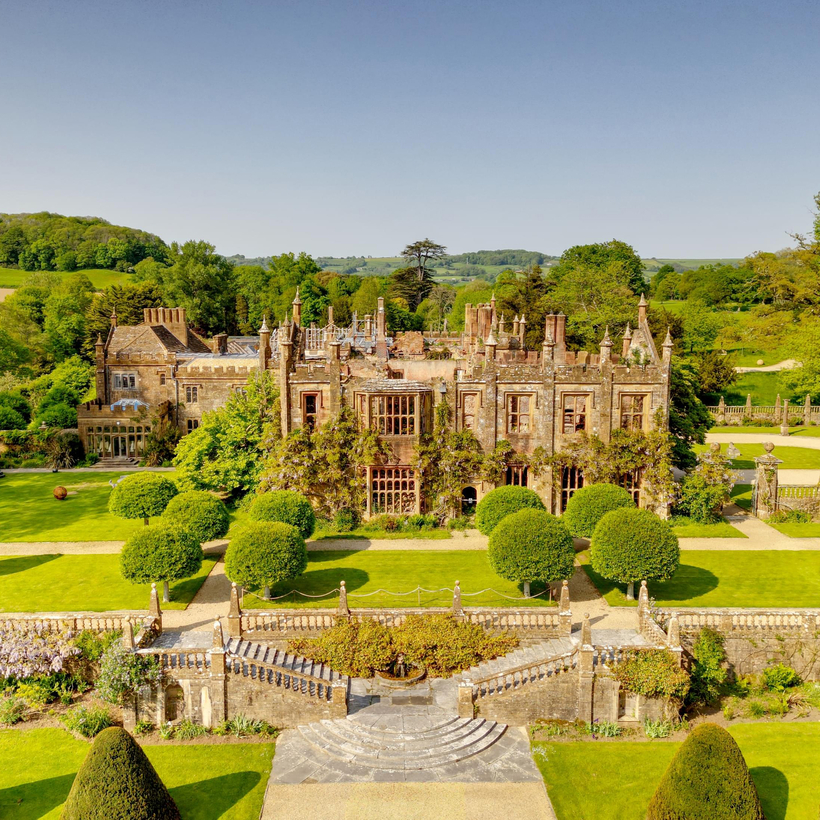A scripted invitation bearing the words “at home” is the apogee of British social life.
This magic phrase often means a weekend at a grand country estate. After an indulgent meal, there may be some late-night dancing in a basement disco. After breakfasting off a hangover and enjoying the services of the valet and housekeeper, guests then while away the morning in the ornamental gardens. Best of all, there’s no need to vacate at 11 a.m. or worry about mini-bar charges.
This rarefied style of hospitality is what James and Sophie Perkins are offering visitors to Parnham House, their home and estate in Dorset. They have recently renovated it into a hotel, events venue, and restaurant. Heritage, history, tradition, and aesthetics are all honored, but fairy-tale glamour—on a Claes Oldenburg scale—has been added for extra delight.

And what tales Parnham’s wood-paneled walls can tell.
The original structure was built on the outskirts of Beaminster, about 150 miles southwest of London, in the early 1200s by John De Parn, who in more recent times was rumored to be a distant relative of Richard Nixon. Then, in 1522, Robert Strode, the sheriff of Dorset, began construction of the handsome, Grade I–listed Tudor mansion that still stands today.
The Strodes stayed for generations. In the mid-1600s, during the First English Civil War, the widow Lady Ann Strode was killed while trying to prevent Roundheads (the soldiers who supported rebel leader Oliver Cromwell) from barging through its front door.
Eventually, Parnham passed by way of women to the Oglanders, from the Isle of Wight. In 1810, William Oglander commissioned the architect John Nash, who designed Buckingham Palace, to enlarge the house. The garden designer Inigo Thomas, who masterminded the grounds at the royal residence of Sandringham, was entrusted with Parnham’s 37,000 acres.

The family home was sold in the 1900s, and Parnham’s gothic turrets, promenading halls, and endless bedrooms became a nursing home and country club that welcomed Sir Arthur Conan Doyle and the Prince of Wales (later, King Edward VIII) on the weekends. During World War II, the American military requisitioned the house as General George S. Patton’s headquarters in advance of the D-day landings. Patton once invited his boss Dwight Eisenhower over for lunch.
The carpenter and designer John Makepeace bought Parnham in 1976, turning it into a furniture-making academy. One of its resident students was a young Viscount David Linley, the son of Princess Margaret and Anthony Armstrong-Jones. In 2001, Makepeace sold Parnham to the Austrian financier Michael Treichl and his wife, Emma, who spent over $14 million to turn it into a family home once again.
Then disaster struck. In April 2017, Parnham was ravaged by a fire. Its owners watched in horror as roofs fell in and its sumptuous Robert Kime–designed interiors were destroyed. The police immediately suspected foul play. Had Treichl, who had struggled with depression, lit the match himself? (His wife would later say that her husband had confessed, although Treichl claimed to have been at Claridge’s, in London, when the fire started.) Or was it the work of Russian mobsters to whom the financier was rumored to be indebted? The truth may never be known.

Two weeks after the inferno, which took four days to extinguish, Treichl’s body was found in Lake Geneva, his death a suspected suicide. The aftermath—collapsed walls, floors, and staircases burned to nothing, a stable block completely destroyed, a wing uninhabitable—left Parnham almost unsellable. Only a bold buyer with deep pockets and a cinematic imagination would be likely to take it on.
Enter James Perkins, an antiques collector extraordinaire, the owner of Aynhoe Park, a private home available for rent in Oxfordshire, and the house-music entrepreneur who created the popular Fantazia raves. He made just two visits to Parnham before deciding to commit. Where previous viewers saw a money pit, Perkins saw great bones and opportunity—and all for just $3.25 million.

To raise the funds, he sold off a large part of his Brobdingnagian collection of curiosities through Dreweatts auctioneers, raising more than $5.4 million. A triceratops skull went for $400,000, and his Instagram-famous Flying Giraffe (a stuffed giraffe calf suspended from a bunch of balloons) sold for $165,000. Perkins then sold Aynhoe Park, with its Sir John Soane–designed living room and Capability Brown–landscaped gardens, to Restoration Hardware C.E.O. Gary Friedman, who reopened it as an R.H. show house, for an undisclosed amount.
Parnham’s conditions of sale? That Parnham’s new owners keep the house standing, add a roof, and renovate according to the local authorities’ direction and the exacting standards of Historic England, the government body responsible for preserving and listing historic buildings.
“What we are doing here is a labor of love,” says Sophie Perkins, James’s wife and Parnham’s creative director, who lives with their three children in a home on another part of the estate. (Her plans to use a kinetic crystal sculpture designed by Thomas Heatherwick to connect an old wing of the house to a new event space are currently under review.) “It is slow, complicated, overwhelming, and frustrating, but we have accepted a responsibility to do it correctly.”
After four years of renovations, Parham is entering its new era and welcoming its first paying guests for exclusive use of the west wing. With five bedrooms, it can accommodate around 10 guests, who get the run of the kitchen, dining room, sitting rooms, cellar bar, gardens, and the hallway, decked out in paleontology and taxidermy.

There is plenty of space for parties and weddings; guests can stay at nearby inns. The menu for the restaurant, in the gardens’ converted potting shed, was created by chef Alex Key of the Rocket Store seafood bar, in Cornwall.
After all that work, did the Perkinses earn the approval of the Dorset locals? “I think we did,” says Sophie. “Given James’s background in raves, I think they’re relieved to know that we won’t be turning the house into a mad and crazy nightclub.”
Simon Mills is an editor at Wallpaper* and a writer at The Times of London


